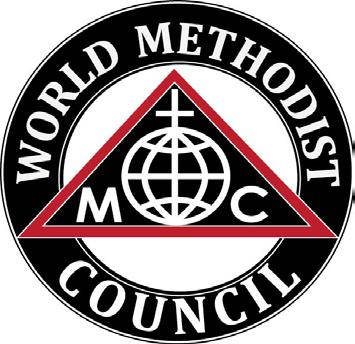

First Friday Letter
The World Methodist Council
Greetings from the President
Dear Friends,
August 2025
Greetings to you in the name of our Savior Jesus Christ. I am grateful for the way God is working through the World Methodist Council and our member churches.
In this First Friday Letter you will read about:
- a proposal to be presented to the World Methodist Council Steering Committee to continue dialogue with the Salvation Army;
- a recap of the second Conference of REDIME, the Network of Discipleship Studies gathering Methodist Churches in Latin America and the Caribbean;
- the launching of a campaign by WesleyMen Worldwide with the purpose of collecting and sharing Pentecost stories;
- the learning and inspiration experienced by participants in the Youth and Young Adults’ Peace Pilgrimage to Korea;
- and so much more.
Each of these initiatives began with the vision of Methodists around the world. Vision is important. Indeed, much has been written about it across the years.
Vision: The Book of Proverbs says, “Where there is no vision, the people perish . . .” (Proverbs 29:18 KJV). Similarly, agricultural scientist and inventor George Washington Carver is quoted as saying. “Where there is no vision, there is no hope.” Author and political activist Helen Keller made a statement about vision that was especially impactful because of her physical deafness and blindness. “The only thing worse than being blind is having sight but no vision.”
I am thankful for the World Methodist Council’s vision statement which has guided our ministry for decades. Our vision is “spreading the Gospel and making disciples of Jesus Christ for the transformation of the world.”
Central to the World Methodist Council’s vision is the formation of disciples of Jesus Christ. A definition of spiritual disciples that I learned several years ago from SLI (Spiritual Leadership, Inc.) is below.
Spiritual Disciples: A Passionate Spiritual Disciple (PSD) is a Christ-follower committed to imitating Jesus’ example. Filled with and guided by the Holy Spirit, PSDs demonstrate the fruit described in Galatians 5:2223 as love, joy, peace, patience, kindness, goodness, faithfulness, gentleness and self-control. A PSD is in covenant with other Christ-followers to grow spiritually, missionally and relationally.
Yes, vision is important. Without it, we struggle to thrive, find hope and see clearly. With it we develop meaningful proposals, organize profound conferences, launch inspiring campaigns, offer life-changing pilgrimages and more.
How grateful I am that the World Methodist Council has clarity around our vision. I invite you to join me in praying for us to become increasingly effective in moving toward our vision day by day.
As always, it is a joy to serve as your President.
Blessings,
Debra Wallace-Padgett

Photo
From the General Secretary’s Diary
The 160th Anniversary Celebration of the Salvation Army
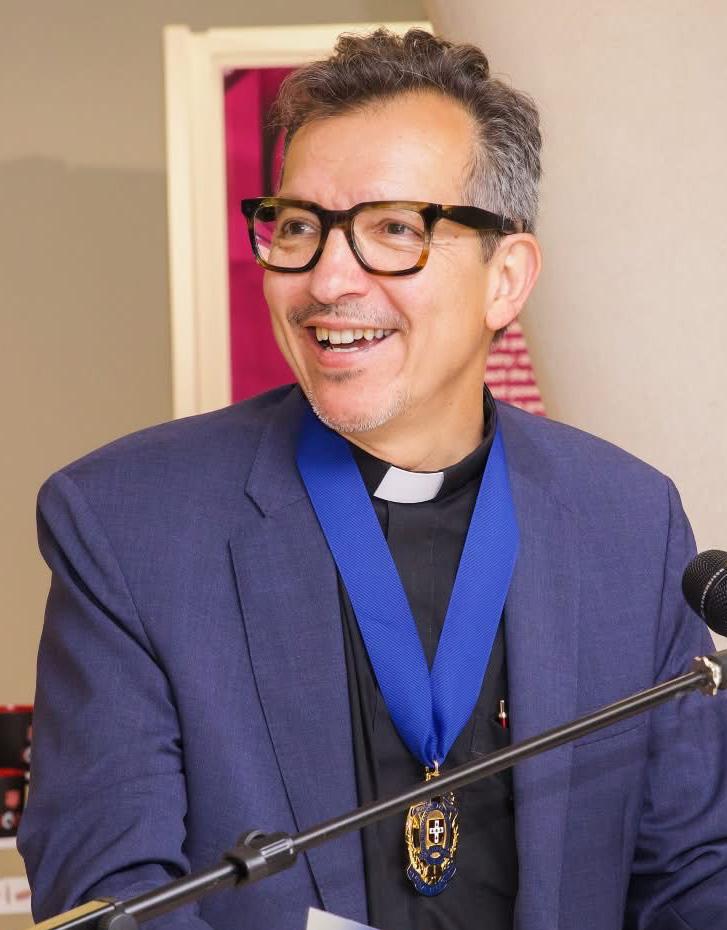
It was a happy occasion when the whole International Headquarters of the Salvation Army gathered downstairs at the 101 Cafe for a broadcast event to mark the 160th Anniversary of the Salvation Army. This is their steel and glass building on the north side of the Millennium bridge over the Thames, in London. The land was acquired by William Booth himself. What a vision!
There was also the presence of representatives from around the world. A group of youngsters stood out. They came from many different parts of the world. Some greeted me in Portuguese: a young officer from Brazil, a couple of high-ranking officers who had served in Portuguese speaking countries.
The General of the Salvation Army International, Lyndon Buckingham, spoke encouragingly about the mission of the organisation. The aim was to look forward in faith and dedication to the call they have received from God.
The Salvation Army sets an example of coordinated action, even Internationally, to serve those in need; engage in emergency response; combat human-trafficking; provide clean water; food security; gender justice, and supporting women and girls. They also engage in broader community development projects and work to overcome poverty and injustice. They provide support through Salvation Army corps - corps is what they call their Halls. This is local action, including service for the homeless, and ministries to children and youth. They have developed a resource to discuss issues around family, gender, sexuality, marriage, divorce, cohabitation, domestic violence. These are principles and examples of how to conduct reflection around these areas. I met a young woman just start working for the SA International in the area of sexuality.
The visit to them proved to be a learning experience for me of how the Salvation Army is focusing on their discipleship of Christ, worship and fellowship, and focusing on their witness and service in the world. As many other denominations in Europe, they are concerned about diminishing membership numbers. But in other parts of the world they have a growing
membership. Jane Paone, their International Commissioner for ecumenical relations, said simply that, they always should invite people to join the Salvation Army.
We had a recent meeting of a dialogue group Salvation Army/World Methodist Council in Cambridge, UK, just before Christmas, December 2024. As a consequence, there is a proposal coming to the Steering Committee meeting to take place in Ghana this August 2025 for a creative continuation of the Dialogue with the Salvation Army. First to run a piece of research to identify good practice where Wesleyans/ Methodists are cooperating with the Salvation Army. Secondly, to see where this would take us.
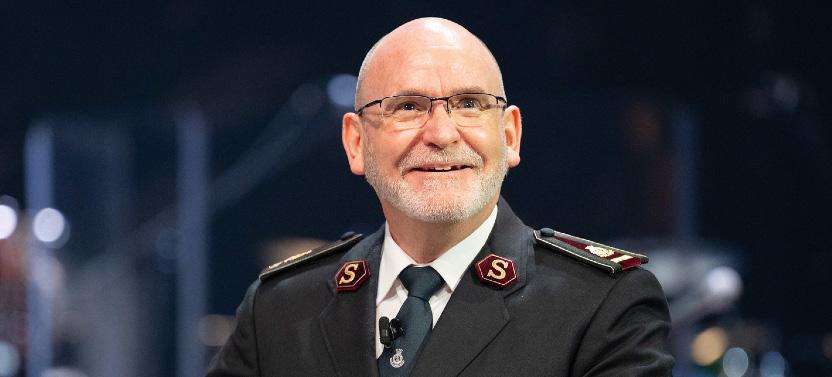
Lyndon Buckingham, The General of the Salvation Army International
When I spoke after the General, I emphasised my admiration for the Salvation Army and my respect for its ministry and its historic roots in Methodism. I have visited William and Katherine Booths’ tomb and reflected deeply on their spiritual struggle between the Chapel and the Hall. Where should the ministry of the Methodist Church and my own be focused? I asked the General afterwards, how relevant is the Wesleyan heritage of the Salvation Army? He said, it is essential; the Wesleyan heritage is fundamental to the Salvation Army.
I finished my speech singing one of Charles Wesley’s many hymns that are invocations of the Spirit and commitment to the service of the poor:
Jesus, the gift divine I know, The gift divine I ask of thee; That living water now bestowThy Spirit and thyself, on me; Thou, Lord, of life the fountain art; Now let me find thee in my heart.
Thy mind throughout my life be shown, While, listening to the sufferer’s cry, The widow’s and the orphan’s groan, On mercy’s swing I swiftly fly, The poor and helpless to relieve, My life, my all, for them to give.
Reynaldo F. Leão Neto, WMC General Secretary
The Second Conference of REDIME
The second Conference of REDIME is available on the World Wide WEB
REDIME, is the Network of Discipleship Studies gathering Methodist Churches in Latin America and the Caribbean.
It takes the the theme: “The Missionary Challenges for Latin America and the Caribbean: Wesleyan Paths for Pastoral and Missionary Practices.”
This presentation organised by REDIME was held on the 28th June. It was broadcast via videoconference and recorded for those who want to listen to it at any time.
The presentation was led by Bishop Luis Andrés Caicedo of the Colombian Methodist Church, and the response was entrusted to Rev Fabián E. Rey, presbyter of the Methodist Church of Argentina and the Dean of UCEL - Centre Educational LatinoAmerican at the National University of Córdoba.
Bishop Caicedo argued that the mission in Latin America and the Caribbean happens in a maze of social, spiritual, and cultural challenges. Amid so many bifurcations, Caicedo invites the search for a guiding thread, inspired by Wesleyan thought, that can guide us and help us find our way out of this maze.
Strong bonds, authentic encounters, community cooperation, and mutual care are the keys to building community, which will be the guiding thread. The Wesleyan insights relevant to facing challenges are found in social holiness, the Wesleyan quadr lateral, and the integration of faith and community action. The emphasis on social holiness through the pursuit of justice and mercy in society is a direct corrective to the liquid individualism described by Bauman.
The Wesleyan quadrilateral contributes to integral theological discernment in light of the complexity we face, providing a deliberative and participatory approach.
Active faith in love and community action are a concrete response to social challenges with community projects that attract those who long to belong, offering spaces for welcome, healing, and safe havens.
Bishop Caicedo concludes with an invitation to rediscover joy in community, contrasting it with the dominium of fear.
Rev Rey, the Dean of UCEL, adds that it is the Holy Spirit who mobilises the community for mission. The mission cannot depend solely on community efforts, human structures, and ecclesial frameworks; the church moves because the Spirit propels it, as a life-giving force. The Holy Spirit blows through history, guiding the church to discern where, how, and with whom to walk.
He also proposes that, another contribution that broadens the view in the search for community building is to reinforce the theology of tenderness, framed in terms of compassion, as a means of healing and restoration for the community.
Regarding mission as compassion, it must be through ecumenical dialogue, which is part of our tradition and Wesleyan heritage. The church should not be a mere spectator or analyst of reality; it must embody the feelings of Christ.
He concludes his remarks by highlighting that in the matter of burnout or exhaustion syndrome, it is essential to rescue the role of the community as a source of contagious joy, rest, and mutual care.
It is not enough to just exist; it is necessary to rediscover joy and celebrate life.
We invite you to enjoy the full Conference through the following link: https://youtu.be/oGTMAYn128?si=_zkQr-kzMj-GxCqv
Prof. Andrea Gutiérrez Representative of Latin America and the Caribbean at WMC Steering Committee.
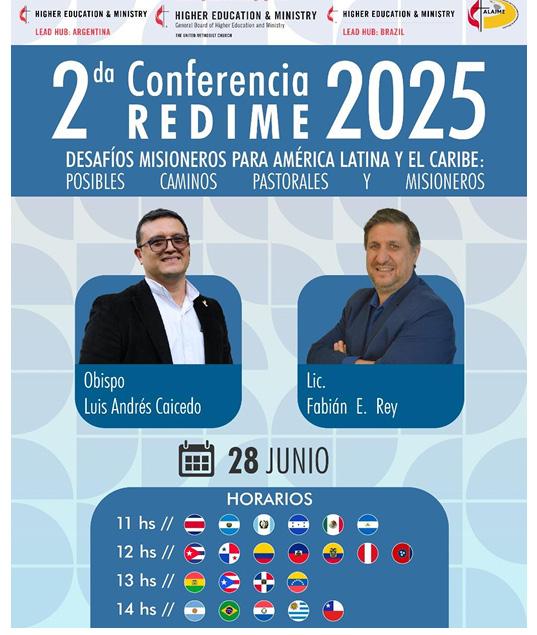
The Spirit Is Moving
We are honored to launch our global Pentecost campaign with a heartfelt message from the President of WesleyMen Worldwide Rev. Edgar De Jesus. In this powerful video, he shares his personal Pentecost story—a testimony of transformation, purpose, and the fire of the Holy Spirit—while encouraging Methodists around the world to share their own stories.
Click the photo to hear more!
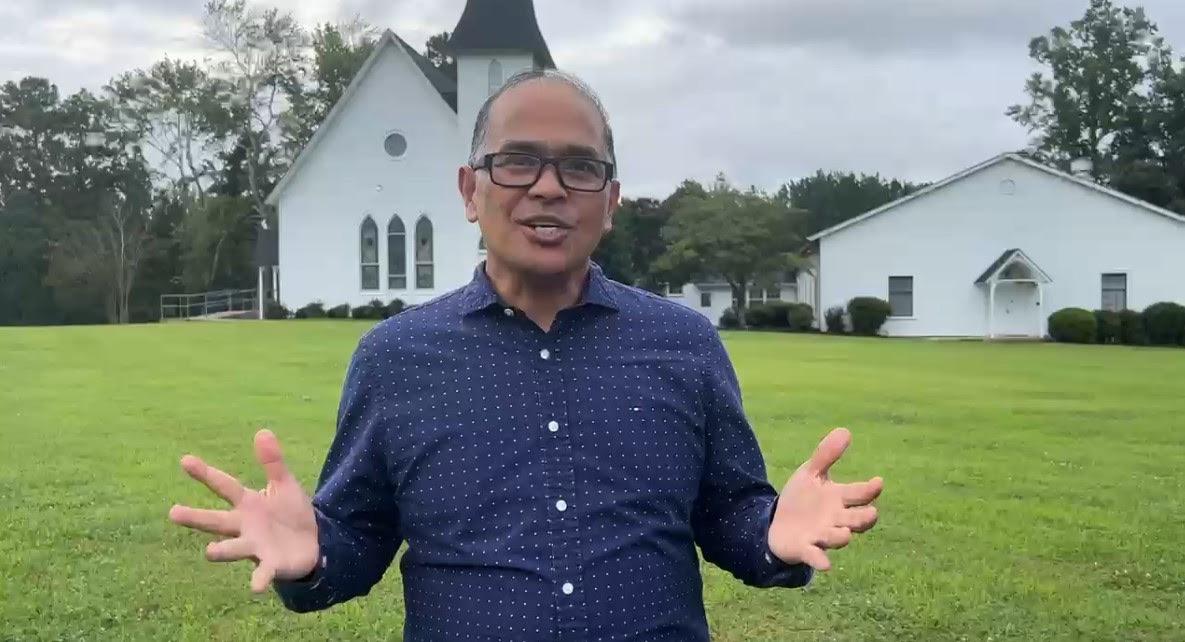
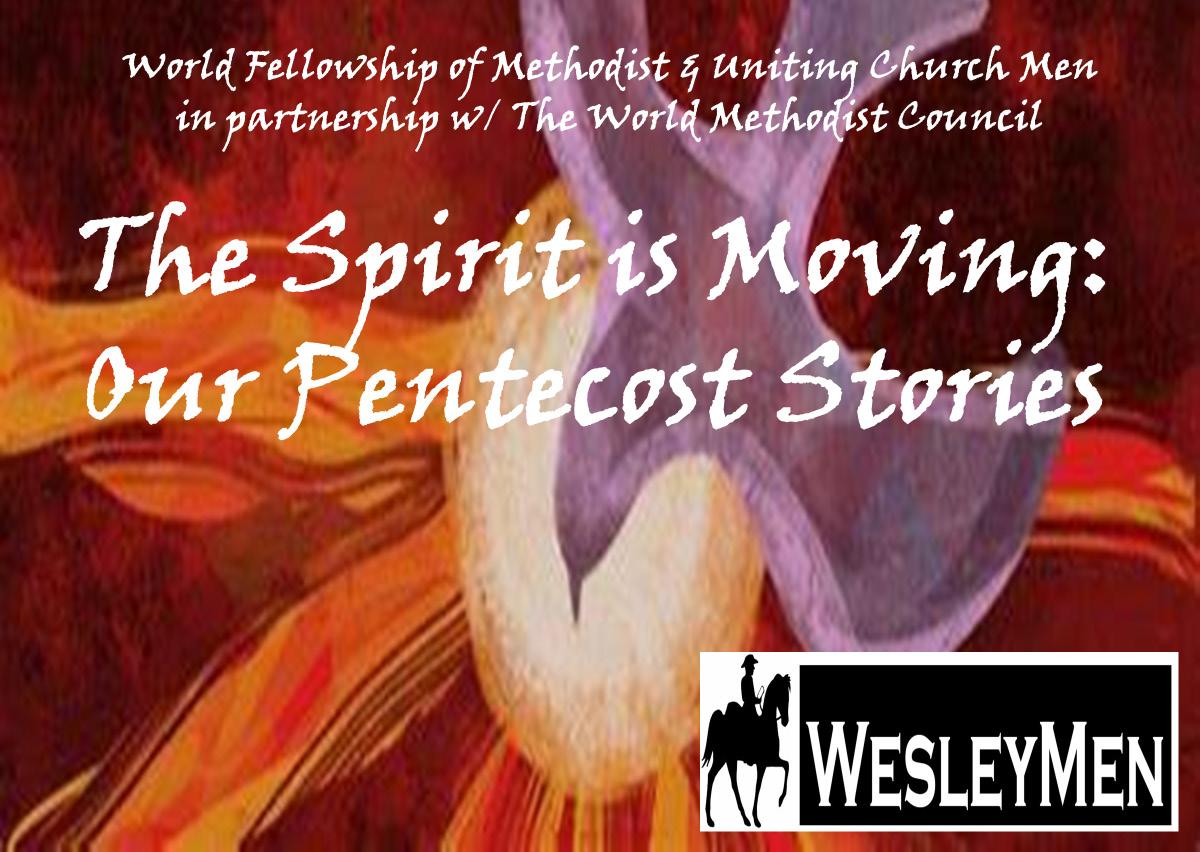
We invite “the people called Methodists” from around the world to send 2-3 minute video clips of your Pentecost stories. You may share a story of your personal conversion experience or a story of how the Holy Spirit is at work in your life, in your ministry, or your community today. The stories will be shared via email and other social media platforms beginning on Pentecost Sunday, June 8th, and throughout the Pentecost season until Christ the King Sunday, November 23rd. Videos may be used in future WesleyMen and World Methodist Council Communications.
Please send a clear video recording to our team at info@wesleymen.org along with your name, church & country. If it’s a larger file, please upload it to Google Drive and forward the link to our team for download.
Indeed, your story is our story and God’s story too! May the power of the Pentecost Spirit be with us always!
A Long Read
Reflecting on The Youth and Young Adults’ Pilgrimage for Peace
From Busan to Pyongyang
I) On the Move - prayers for a unified Korea
The learning from the Youth and Young Adult’s Peace Pilgrimage to Korea is sinking in. More reflection is needed. More understanding of the complex Korean history is called for. More awareness of the consequences - including nuclear - of its present division is needed; and more determination to seek the peace that the Christian faith proclaims and lives out is required.
Let me take the Youth and Young adults at their own words:
“We young people from the World Methodist Communion gathered, supported by the World Methodist Council, the United Methodist Church’s General Board of Global Ministries, and the Korean Methodist Church. We participated in a Peace Pilgrimage in South Korea from June 23 to 27, 2025, representing 17 countries from all corners of the world. The pilgrimage faced the contextual reality from the democratisation movements towards the hope for the re-unification of the Korean Peninsula. Geographically starting from Seoul to Gwangju, Daejeon, Paju, and the DMZ, concluding in Seoul. The pilgrimage aimed to be on the move by listening to and witnessing the devastation caused by warfare and political tensions that have persisted for 75 years on the Korean Peninsula.” (See full statement on July 2025 First Friday Letter)
‘On the Move’ is the theme for the WMC from 2024 to 2029. The young people said that they were on the move. With this single prayerful pilgrimage, the Youth and Young Adults (YYA) showed that the Council can operate in between Conferences, which happen every 5 years. The Council is a highly complex organisation, representing 83 member churches and 80 million Wesleyans and Methodists around the world. Nevertheless, things can happen
on a practical level as this YYA Pilgrimage for Peace proved. It is true that this required lots of WMC time and financial resources. It was worth it: investing in the Youth, and in their engagement with a reconciling project for Korea.
We could only have achieved this working in partnership with the UMC’s General Board of Global Mission and in particular through the generosity of the Korean Methodist Church. The Korean Methodist Church took care of all the hospitality and travel expenditure in Korea. The Pilgrimage for Peace was one of the 14 events commemorating the Protestant Mission to Korea and the Korean Methodist Church’s 140th anniversary.
I was invited to be present at the first event back in April. (See more on the 2025 May First Friday Letter) This was a high profile event within the churches and the country itself. There were several worship services, musical shows, conferences, some with the presence of the local authorities, whilst the national political scene was facing a crisis. The Constitutional Court was engaged in ruling regarding the attempted imposition of martial law by the former president. The celebration’s main emphasis was on the blessings of God that came to Korea through the spread of the Gospel message and the peace that Jesus offers. Somehow the Protestant mission was more successful than the early attempts.
Some of the earlier missionaries and Christians in Korea, before the arrival of Protestant mission1885, had been martyred for their faith. There is a memorial park in Seoul for the Roman Catholic martyrs. In the memorial park there is a path containing prayer stations with symbols and explanations of their suffering and death. It is very near to the Protestant Cemetery where Protestant missionaries were buried outside of the walls of the city. Nowadays it has become part of the bigger city that makes up Seoul.
The Youth Pilgrimage continued
the 140th Anniversary celebrations and had a purpose: to pray for peace in the Peninsula, and a united Korea. Seeing their effort, time and resources that they and organisations put into the Pilgrimage for Peace, made me think of Jesus’ parable of the treasure hidden in a field. Some of the young people raised the money for their air tickets, or part of it. Some faced critical political situations to get to Korea. Two could not make it because of the situation in Palestine and in Haiti. The Trump administration’s ban on immigration meant that Haitians could not even land on connecting flights. A Palestinian young person could not get out of the country. Another Palestinian woman who holds an Israeli passport was able to participate.
II) Light shines on a peaceful field
The imagery in Jesus’s parable about the treasure in a field, in Matthew 13:44 is echoed by R. S.Thomas’ poem: “The Bright Field”. In it the Welsh poet explores the concept of finding profound meaning and spiritual significance in seemingly ordinary and hidden moments. The ‘bright field’ momentarily illuminated by sunlight demands that the narrater (of the poem) must give all that they have to posses it.
“I have seen the sun break through to illuminate a small field for a while, and gone my way and forgotten it. But that was the pearl of great price, the one field that had treasure in it. I realise now that I must give all that I have to possess it.” (R. S. Thomas)
In Korea there is a bright field: the belonging to one another of the people of the whole Peninsula. This has the potential to bring about a peaceful political reality. It is already at hand, and yet it remains a dream. Korea has a long and complex history, but if one is asking how long Korea was unified as a single country, the answer depends on how we define “unified Korea”, geographically and/or politically.
Continued on next page...
A Long Read continued...
For approximately 1,250 years Korea was politically unified under different regimes: Silla (668-935), Goryeo Dynasty (918-1392); Joseon Dynasty (1392-1897); Korean empire (1897-1910); and under Japanese occupation (1910-1945).
Korea was divided into North and South Korea after the Second World War. Tensions remained in the earlier period between the two Koreas with some military operations, until, connected with the so called Cold War, North Korea invaded the South in 1950. The outcome of the Korean War of 1950-1953 was a permanently divided Korea. Geographically, the division coincided approximately with the 38th Parallel.
He acted with the support of the the Soviet Union and China, miscalculating that the United States of America would not get involved. But in fact, the invasion ultimately triggered a full-scale war. Initially it was successful, reaching Seoul in three days and rapidly reaching Busan further south. The war imposed heavy loses on the civilian population. It is said that around 3 million lives were lost.
I saw with my spiritual single eye, a ‘bright field’ illumined by a ray of light for peace. That vision had within it an extended Pilgrimage from Busan to Pyongyang. I dreamt it would be a unifying journey, from the very south of South Korea to the capital of North Korea. It would have united the Korean Peninsula in prayer and encounter. It would have gone across the 38th Parallel unimpeded. It would have boasted opportunity for shared meals, and hospitality. It would be a sign that those on both sides are united by their ancient history, their language, their culture, and in a hidden manner if necessary, by their Christian faith. This is not to diminished what WMC achieved with the YYA Pilgrimage from Seoul to the border with North Korea. It is instead a vision that sees the potential for a future Pilgrimage when the visit of internationals would offers an unique opportunity for learning of peace and co-existence.
iii) The Christian faith is everywhere in Korea
Everybody knows that Christianity is strong in South Korea. What many don’t know is that Christianity is strong in the North too. There are four ‘official’ churches in Pyongyang: 2 Protestant, one Roman Catholic, one Russian Orthodox. In spite of the alleged persecution of Christians, yet Pyongyang claims that there is religious freedom, with officially estimated numbers of 10,000 Buddhists, 10,000 Protestants, and 4,000 Catholics. The Catholic Church in North Korea has no official ties with the Vatican. South Korean Catholics refer to the situation in North Korea as the “church of silence” due to the restricted and often clandestine nature of the Catholic practices there. South Korean Protestants refer to their counterparts in the North as underground churches, understood to be meeting in family units or small groups, practising their faith in secrecy and discretion, like the Catholics.
Christianity is historic in North Korea. The revival movement at the beginning of the 20th Century started in the Northeast of the Peninsula. It is known as the 1903 Wonsan Revival Movement. It came to Pyongyang, as the Great Revival 1907-1910. Pyongyang became known as the ‘Jerusalem of the East’. The revival started after a period of intense prayer and Bible study among Korean Christians with some input from Western missionaries, but led by Korean ministers. A key figure in the movement was Kim Son-chu. The revival led to widespread public confession of sins, including sins of racial prejudice, hate, anger, and jealousy. This resulted in repentance and conversions, with a significant increase in church attendance. The great-grandparents of the current North Korean Leader Kim Jong-un, were devout Christians. They were well known in the churches in the North in the1940’s. Their son, Kim Il-Sung, self-styled and reversed as the ‘eternal president’, is said to have asked the doctor for prayers when faced with a serious operation.
The success of the Youth Pilgrimage for Peace is due to the prayers and the deep desire for peace and unity in the Peninsula. It draws attention to the ‘bright field’ so that it is not forgotten. So that there is a realisation that it is possible, in a sense already here, and yet far away in the distance. There are leaders keeping the hope alive. The former WMC President, Dr J. C. Park, is working towards reconciliation and peace, and participated in the Peace Pilgrimage.
I had the privilege to meet Professor Kim and Elder Kim who called my attention to the Christian revival’s roots being in North Korea, and also have a vision for a One, Green Korea. They are part of an environmental movement dedicated to protecting Korea’s nature and promoting a more sustainable way of life. They work on various environmental issues, including wildlife conservation across the Peninsula. They seek protection of the endangered species still present in the habitats around the Demilitarised Zone and the Baekdudaegan Mountain Range. The movement is campaigning to turn the DMZ into a UNESCO World Heritage Site. They work in collaboration with NGOs and with the North Korean Government. They claim that since their foundation they have planted more than one million trees in North Korea.
What would happened if the DMZ became also porous? Would old family ties be regained? Would people encounter in an embrace? Would Christians recognise one another and join in worship and praise?
Surely, it would be hard at the beginning but eventually it would get easier and hopefully the prospect of war would disappear. Cultural differences can be sensitive. There is a prevalent perception of a more severe culture in the North. That contrasts with the perception of a freer spirit in the South, albeit a work-stressed and tense lifestyle. There is a relentless go-getting attitude in the Seoul.
Continued on next page...
A Long Read
However, I bet the cultural and faith links would bring people close very quickly. I felt something had changed in Seoul. It used to be a heavy drinking and smoking city with stressed out workers. It seems now to be a more relaxed city, with plenty of easy going fashionable Koreans. One day, I would like to be able to describe Pyongyang too. That day will come.
In Seoul, I found an attractive and proud K-culture popular in particular with the youngsters. I witnessed that confident approach, a stress-free positivity of young urbane Koreans gathered in a simple restaurant in a little corner off one of the street markets in Seoul. They were enjoying the two main dishes on offer: raw lean meet topped with an egg yoke equally raw served on a wooden plater and/or, the other local speciality on offer: a bowl of small pieces of raw octopus, still wriggling, accompanied by a dip, a sauce with delicate flavours in sesame oil. I enjoyed both very much. I also loved the romantic, a little seedy environment, only disturbed by the occasional lifting out from the tank of the next live octopus to be cut out into pieces by one of the three women running the restau-
rant, a cleaver applied against a big piece of wood.
The evening was courtesy of Rev Lee - acting under orders no doubt of Dr Hwang (the KMC Director of Mission) - who took pity on us after so many days of official commitments and decided to take us out for a K-treat. That is where he takes his family when they come for a day out in Seoul.
I asked what had happened to the culture of heavy drinking that a successful business life required in Korea in recent past? The restaurant was free of smoking and there was only very moderate drinking of a local alcoholic spirit. The answer was: “it is out of fashion these days! We have cleaned up our act!”
They seemed to have cleaned up their acts also regarding a more belligerent approach to North Korea. I had noticed that the broadcasts warning of a North Korean invasion were not blasting out from the loudspeakers on the way from and to the Incheon Airport any more. On previous visits, I found them very disturbing, fear inducing, creating a sense of imminent danger, provoking panic. It is much better now without that
message blasting out.
IV) Learn war no more
At some point I had proposed a WMC School of Peace Studies. I feel it is happening as the Youth and Young Adults take on projects that focus on peace-building, promoting faith in a peaceful future. Present geopolitics are driving policy makers to think that an all out world war is coming in a near future. Some have started preparing for it. The WMC YYA Programme instead is investing and working on peace diplomacy to avoid the war.
Here is the importance of the YYA Peace Pilgrimage. It is a lesson that war is not the solution to conflict, instead that creating space and time to understand the other, walk in others shoes, and diplomacy is the way of co-existence.
“Do not repay evil for evil or abuse for abuse; but, on the contrary, repay with a blessing… Let them turn away from evil and do good; let them seek peace and pursue it.” (1 Peter 3:9 and 11)
Written by WMC General Secretary, Reynaldo F. Leão Neto
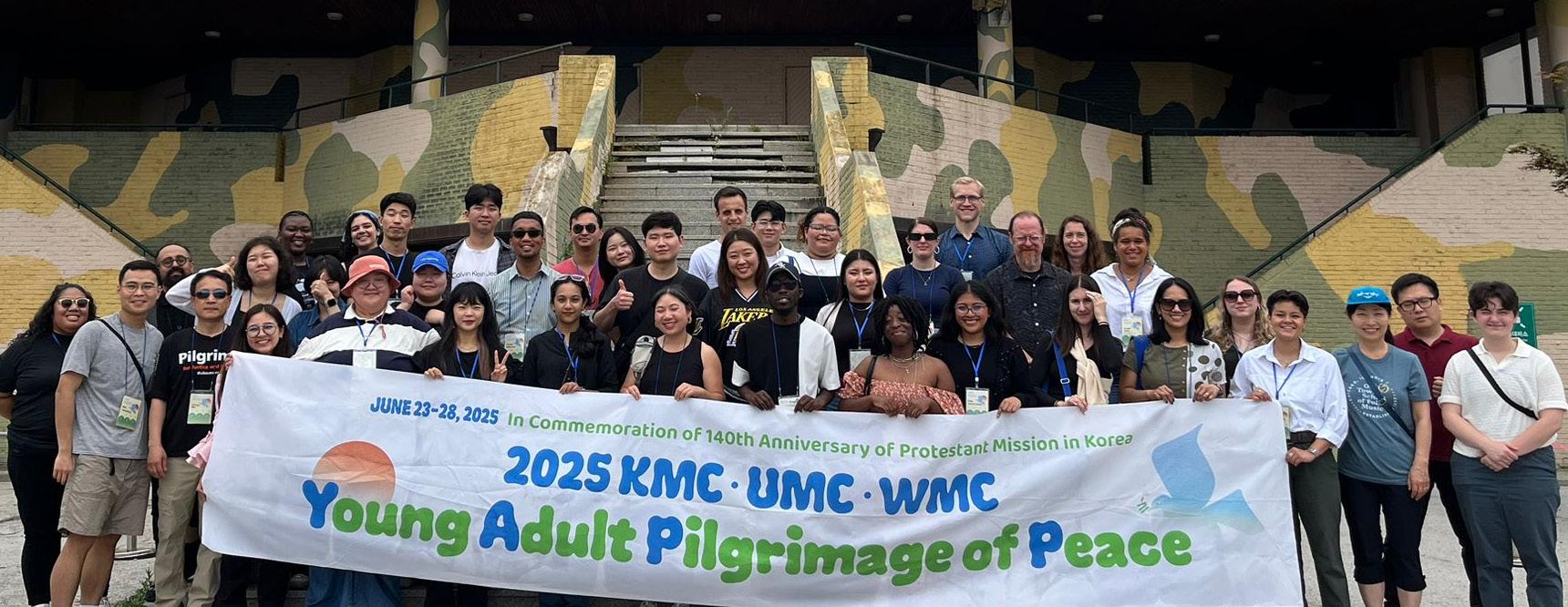
Young Adult Pilgrimage of Peace at the DMZ Observatory
Book Review: A History of the World in 47 Borders
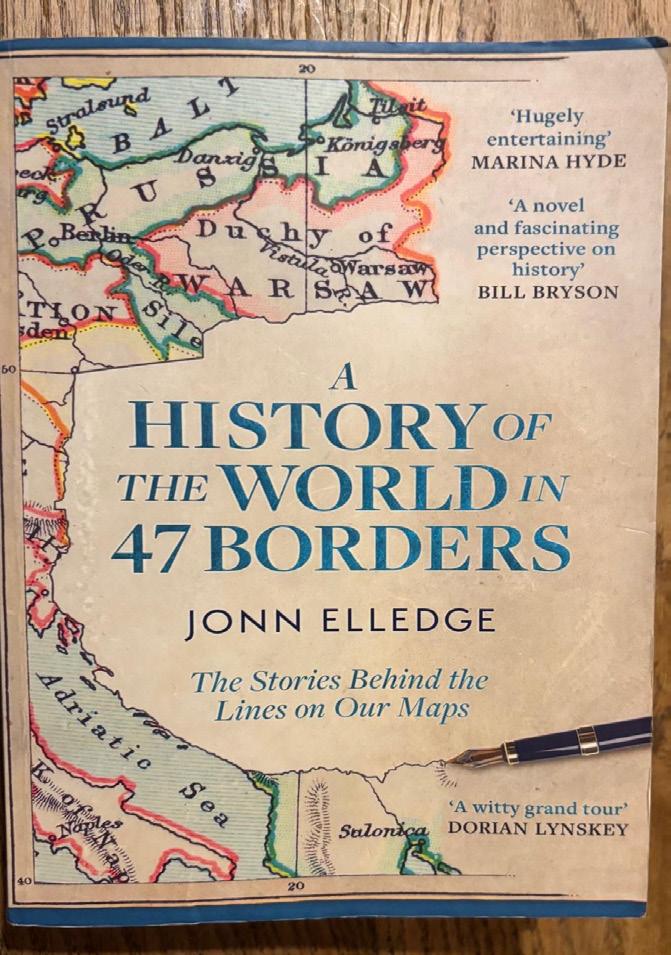
Relevant to the theme of the World Methodist Council for this quinquennium, 2024-2029, “On the Move”, the book published in 2024 and now in 2025 in paperback, ‘A History of the World in 47 Borders’, could not be a more fitting reading. The book is written by John Elledge and published by Wildfire. It tells the stories behind the lines on our maps.
It is almost 400 pages of wit showing the absurdity of borders that have become in the present geopolitics deadly. It shows that geographically Europe is just a massive peninsula, a continuation of Asia, having no body of water or proper range of mountains dividing the two Continents. It is a construct that makes no geographical sense. It goes from Ancient Egypt, one of the first borders known in the world, between the White and Red Egypt, millennia before Christ, to the division imposed in Africa by the 1884 Berlin Conference when European governments carved Africa: “where no white man ever trod”, this being the title of one of the chapters. They divided Africa into some 15 areas, claimed by them as theirs. The result of the scramble for Africa was that by 1913, the vast ma-
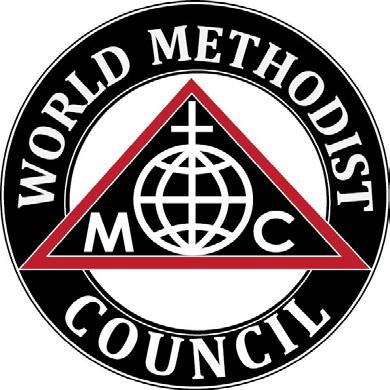
jority of the African continent was dominated by a handful of European powers. Some borders are a straight line as if drawn with a ruler onto a map.
The book also shows how colonialism imposed lines that made no sense to the Arabic World, made by the arbitrary actions of relatively low-ranking officers. These are various spheres of influence set out in the Sykes-Picot agreement of 1916. Only the mention of their names provokes repulsion in Arabic ears to this day. The consequences of that colonial act and of the Balfour resolution from the following year, are playing out tragically to this day.
The borders linked with the Cold War are also analysed, from the Demilitarised Zone on Parallel 38th degree dividing the Korean Peninsula, to the Berlin Wall that came down in 1989/90. In this way, the book is a descriptive, funny and critical history of the world based on the ability of those in power to draw lines on a map with terrible consequences for those on the ground. By reading about the erratic stories of these borders, one can learn a lot about the randomness of national identities. The description in itself, without being overtly ideological, calls for a profound reflection on the reasons why and how such arbitrary lines shape the identity of nations and peoples.
From a faith perspective we should never stop asking whether those on the other side of an arbitrary border, or a natural border for that matter, still carry in them the image of God, if Christ died for them too, and if the Spirit is able to empower them to live for the glory of God and in peace with creation.
THE WORLD METHODIST COUNCIL
welcomes all to an evening honoring H E Dr. Fatou Bomm Bensouda, recipient of the 2025 World Methodist Peace Award Tuesday, August 12, 2025, 7:00 p.m.
Wesley Towers, No. 3 Cruickshank Rd, Accra, Ghana
Co-hosted by The Methodist Church in Ghana
Since 1977, the World Methodist Council, representing 80 million Methodists globally, has honored individuals who contribute to peace, reconciliation and justice. Dr. Bensouda will be recognized for her courageous efforts worldwide. For questions regarding the ceremony please contact communications@worldmethodistcouncil.org
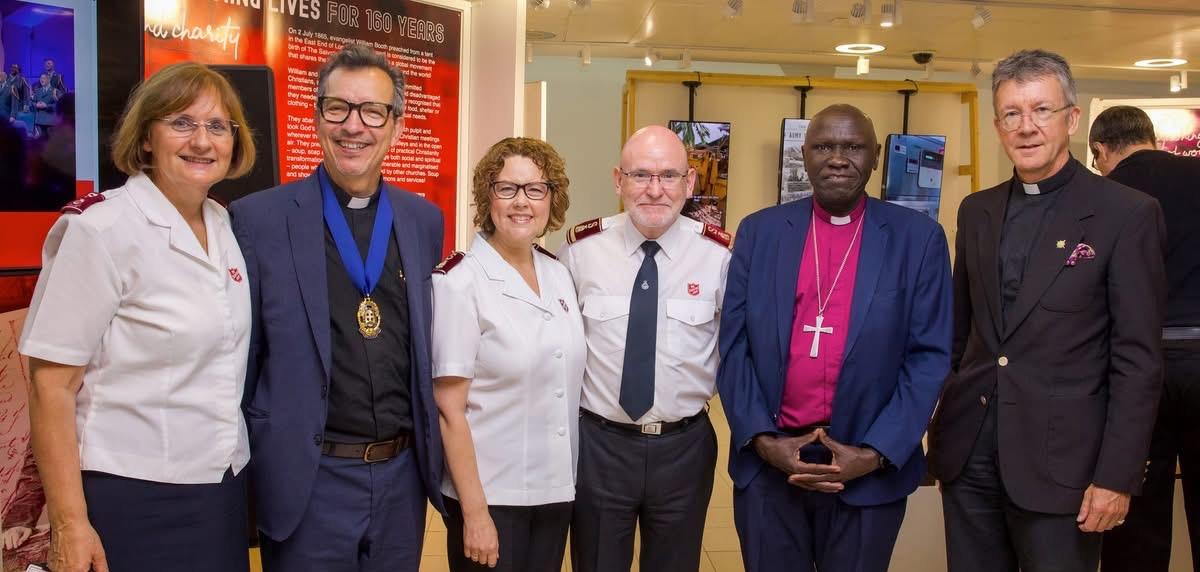
Please send press releases, articles and resources! Submissions should be a page or less (450-500 words), edited and ready to publish. Contact us by Monday, 25 August at communications@worldmethodistcouncil.org if you would like your story to be included in the September edition of the First Friday Letter.
On the Web
This and past First Friday Letters can be found online at FirstFridayLetter.worldmethodistcouncil.org
The World Methodist Council’s website may be found at worldmethodistcouncil.org
To subscribe to this newsletter, please email communications@worldmethodistcouncil.org.
About the First Friday Letter
The First Friday Newsletter is a monthly publication of the World Methodist Council.
Publisher: Rev. Dr. Reynaldo F. Leão Neto, General Secretary Communications: Michaela Bryson
All stories and photos, unless otherwise stated, are protected by their respective copyrights. Please do not copy without expressed written permission from the Council.
Follow the Council on social media!!
@World Methodist Council
